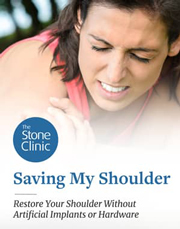Rotator Cuff Tear or Injury: Symptoms, Treatment, & Recovery Time
When a rotator cuff tear or rotator cuff injury occurs, even simple tasks—like reaching back to put on a coat—can feel impossible. For over 30 years, we’ve pioneered non-operative and minimally invasive methods to restore function and relieve shoulder pain, helping our patients return to active lifestyles with minimal disruption.
What is the Rotator Cuff?
The rotator cuff is a group of four muscles and tendons surrounding the shoulder joint. The cuff is responsible for holding the upper arm bone securely in the shoulder socket, allowing for arm movement while maintaining shoulder stability.
Rotator Cuff Injury Causes and Symptoms
Causes of Rotator Cuff Injuries
Rotator cuff injuries can happen suddenly or develop over time. Common causes include:
- Trauma: Falling during sports like skiing or biking.
- Repetitive Strain: Overuse from activities like swimming or throwing.
- Degeneration: Wear and tear on cuff tissue from arthritic spurs in the shoulder.
Symptoms of Rotator Cuff Pain
Key symptoms include:
- Pain when lifting your arm or reaching behind you.
- Weakness in your shoulder.
- Night pain, especially when lying on the affected side.
Diagnosing a Torn Rotator Cuff
A physical exam helps identify the cause of shoulder pain. For precise diagnosis, we often use MRI imaging to distinguish between a rotator cuff tear and other issues like bone spurs.


"A careful physical exam helps clarify the cause of shoulder pain. An MRI is usually definitive about a rotator cuff tear versus an impingement from a bone spur. Our surgical techniques are outpatient anatomic repairs, and our patients are usually able to resume all of their former sports activities after completing proper physical therapy."
Rotator Cuff Tendinitis or Shoulder Impingement
Shoulder impingement, also called rotator cuff tendinopathy, “swimmer's shoulder,” or “thrower’s shoulder,” develops when the rotator cuff tendons become irritated. Left untreated, inflammation spreads to other structures like the bursa, resulting in pain, weakness, and limited motion.
Non-operative care is our first line of treatment. Physical therapy targets the mechanical imbalances causing impingement, while injections of growth factors and lubrication promote tissue healing. If these methods don’t provide relief, minimally invasive arthroscopic procedures remove the inflamed tissue, creating the space for your rotator cuff to properly function.
Surgical interventions, like bursectomy or debridement, are performed in our state-of-the-art outpatient center under local anesthetic. The result? Rapid recovery, with most patients returning to daily activities within weeks.
Torn Rotator Cuff
Not all rotator cuff tears are the same. Partial tears may respond to physical therapy and platelet-rich plasma (PRP) injections. However, a complete rotator cuff tear typically requires surgical repair to prevent worsening damage and irreversible atrophy.
Rotator Cuff Surgical Repair
Every detail matters. Any required surgery is performed at our outpatient surgery center under a local regional block anesthesia. Using advanced arthroscopic techniques, we ensure an anatomic repair. Sutures and anchors secure the torn rotator cuff back to its proper position on the bone, restoring its function. This precise approach lays the groundwork for fast and effective rehabilitation.
Rotator Cuff Injury Recovery Time & Physical Therapy
Recovery is a journey, and we’re with you every step of the way. Our expert rehabilitation team designs a program that protects the rotator cuff repair during healing while gradually restoring range of motion and strength. Whether it’s reaching for new goals or returning to the activities you love, we aim to help you play forever.
Hear from Patients Who've Returned to Sport After Rotator Cuff Repair
Be inspired by real patients who’ve undergone this procedure, reclaimed their lives, and returned to what they love—whether that’s pursuing high-level sports or enjoying everyday activities pain-free.
Take the First Step Toward Recovery
Don’t let shoulder pain limit your activities. Early diagnosis and treatment are key to managing rotator cuff injuries effectively. Contact us at (415) 563-3110 for an appointment.

